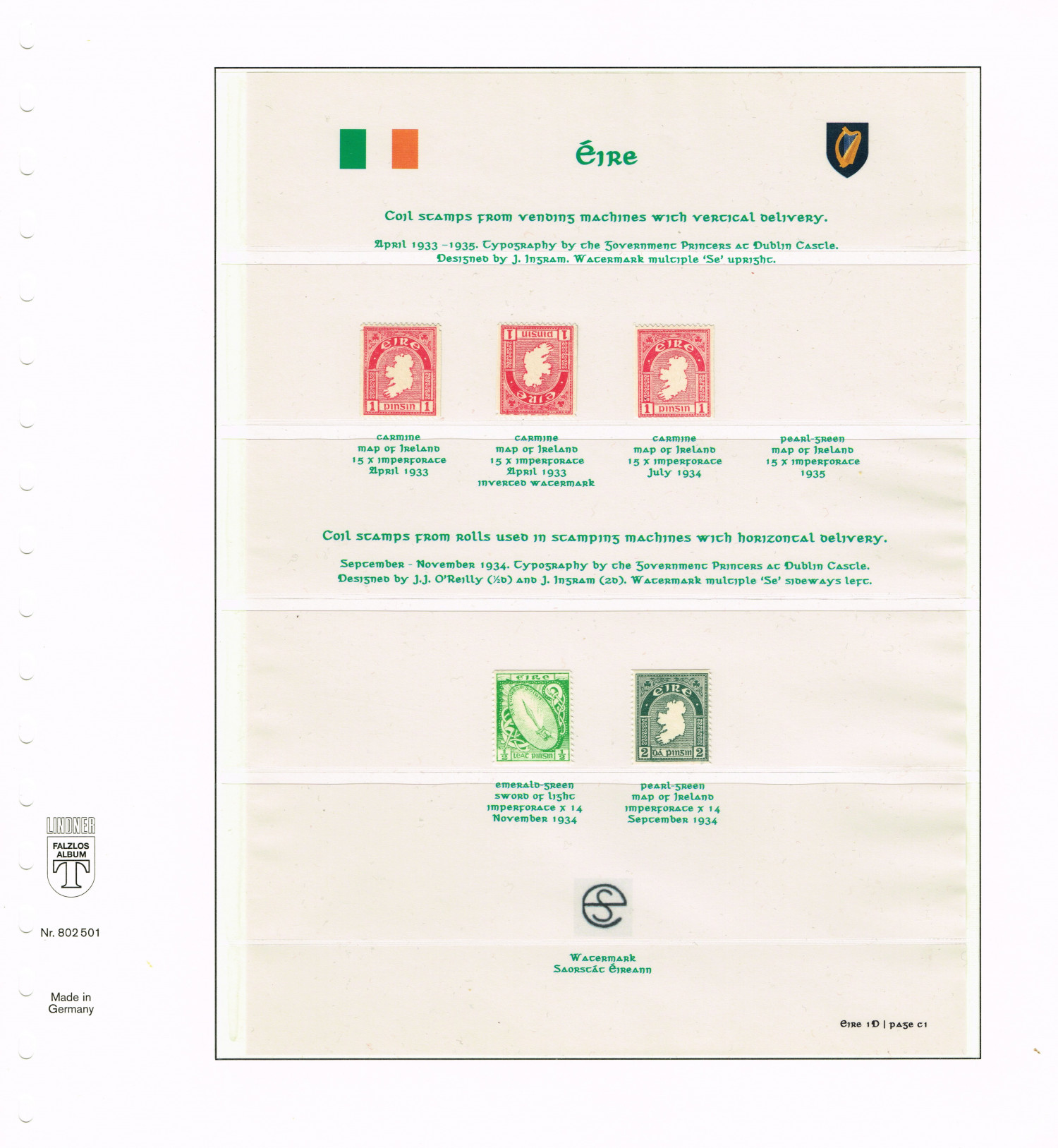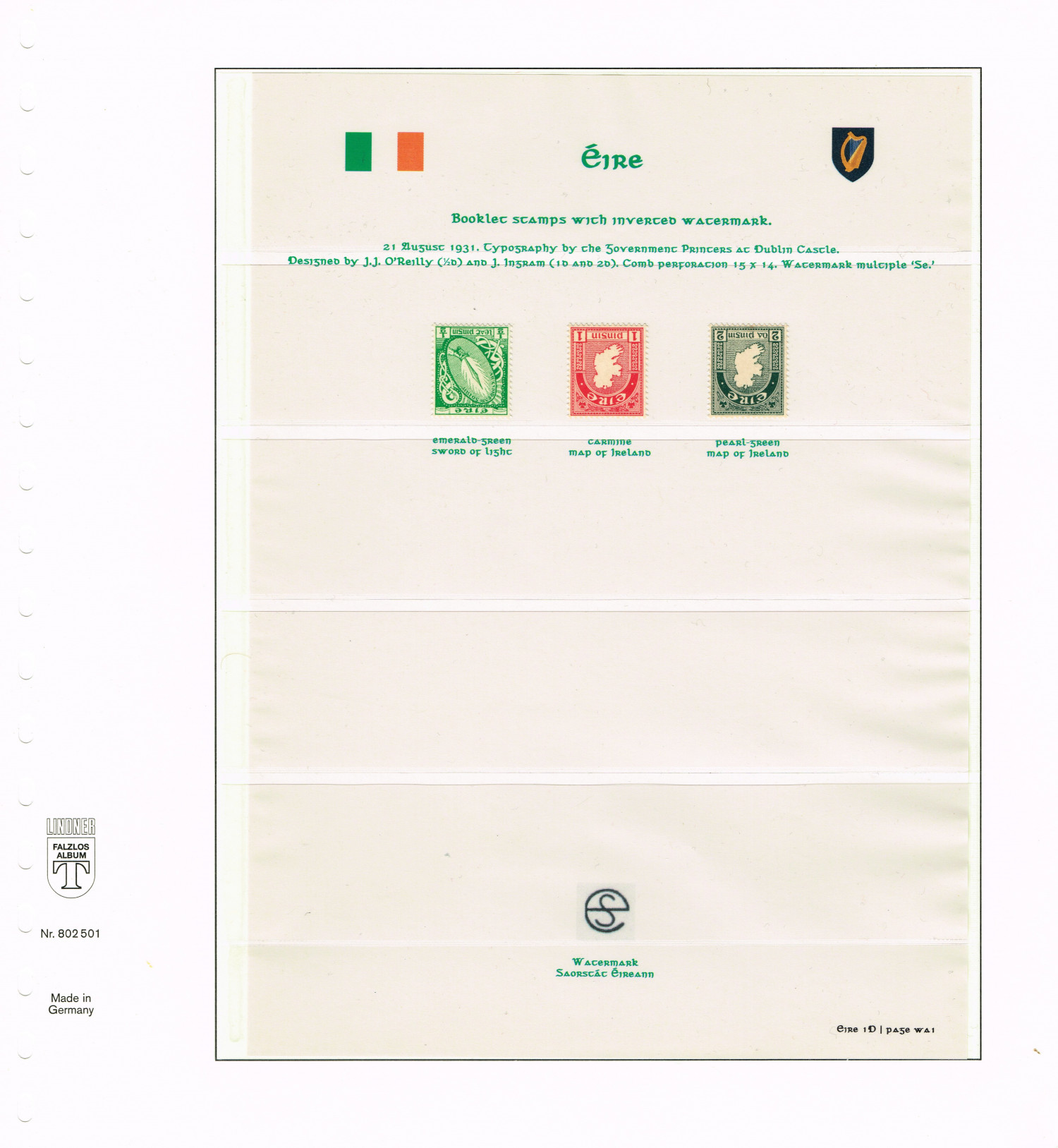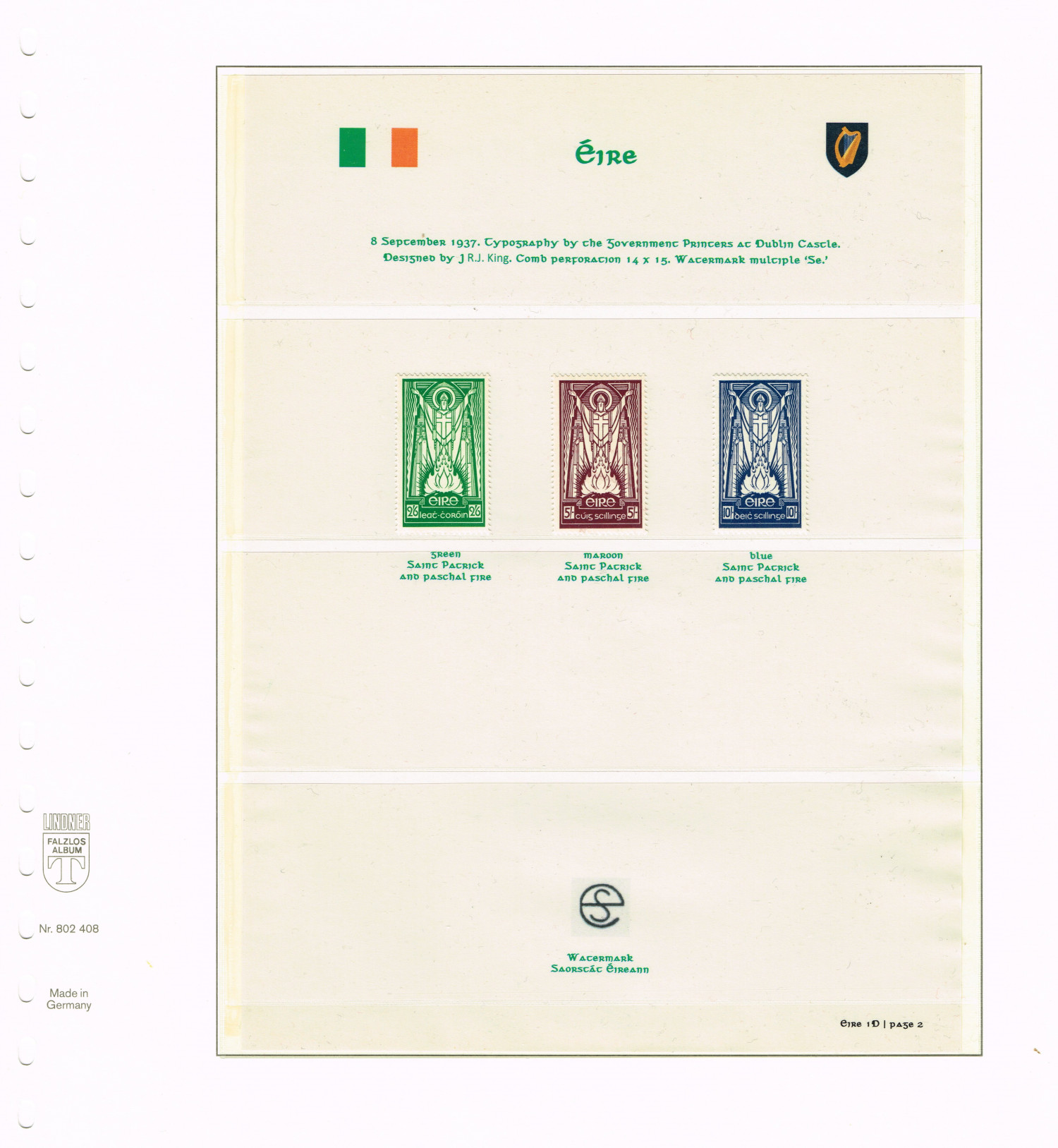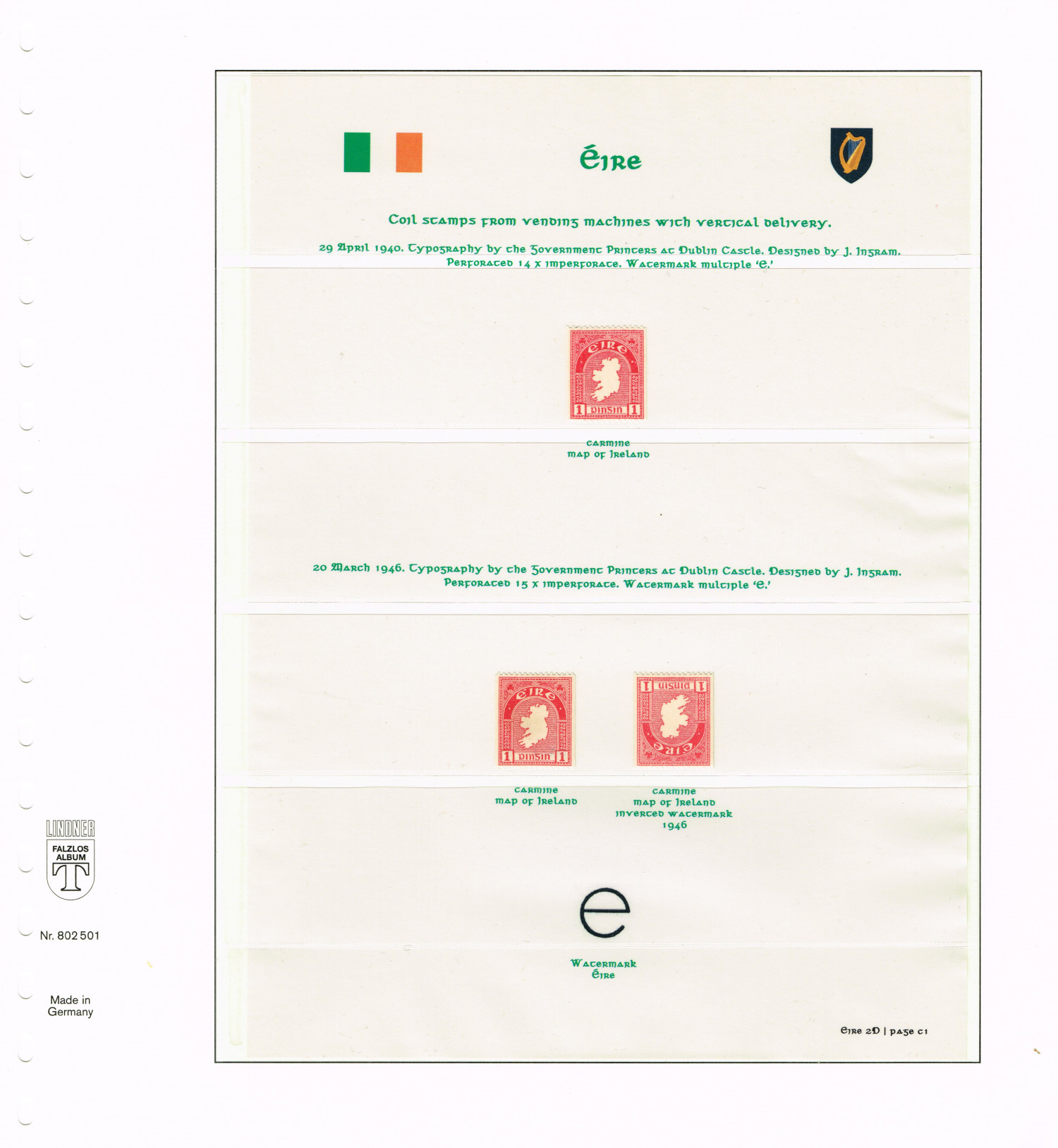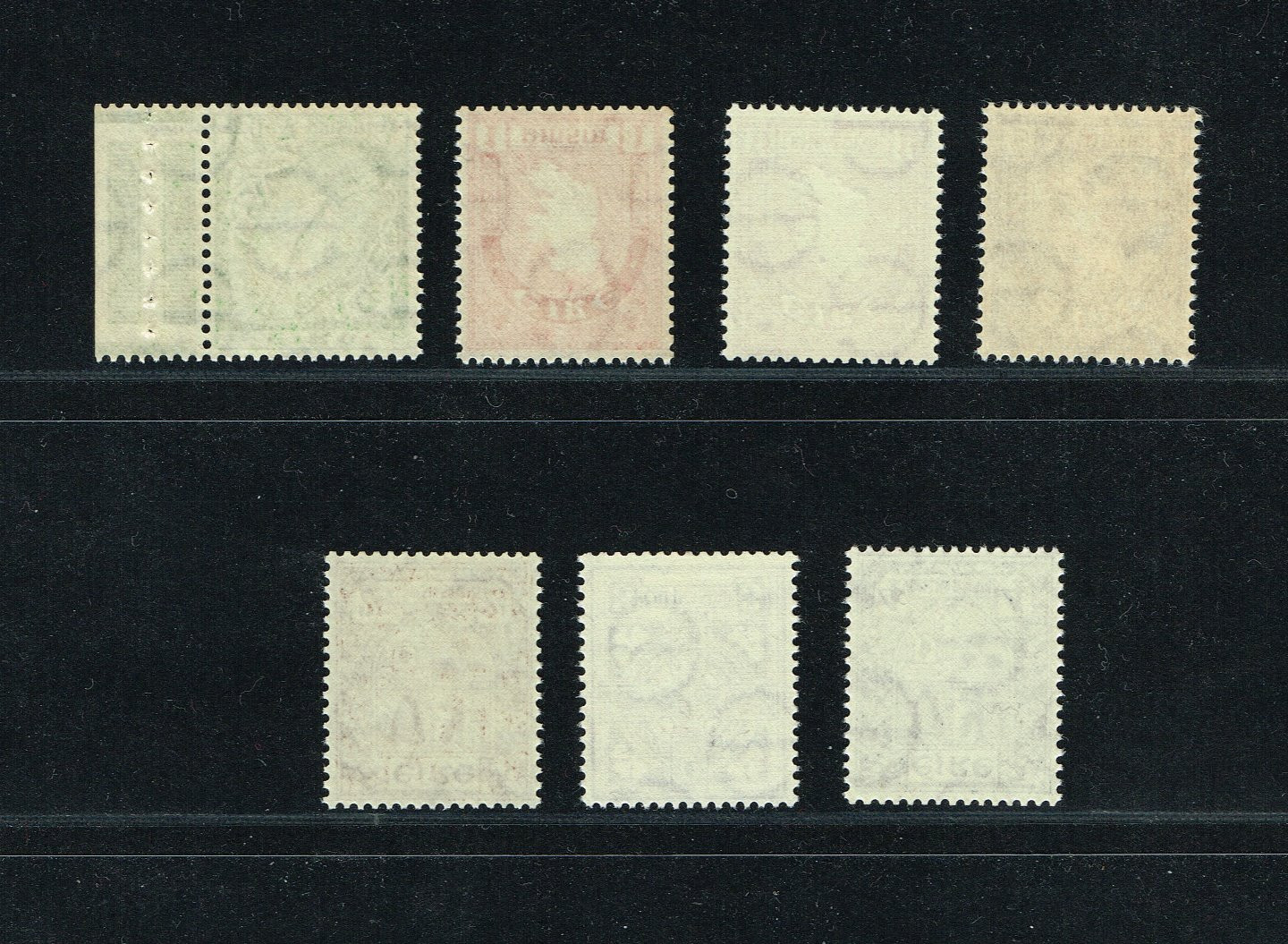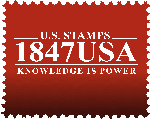Éire - Ireland Definitive Stamps
Exhibit by SCF member NSK
Introduction
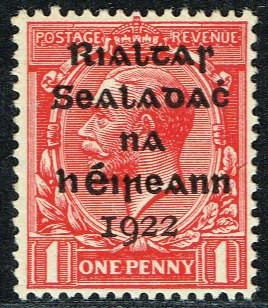
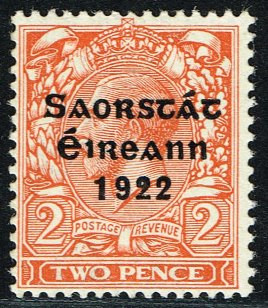
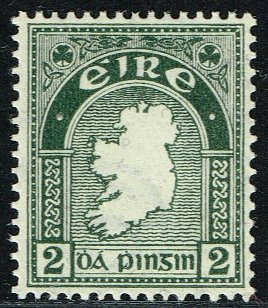
The Anglo-Irish Treaty of 6 December 1921 ended the Irish War of Independence. The treaty provided for the establishment of the Irish Free State (Saorstát Éireann) within a year. The treaty also provided for six provinces in the northeast of Ireland to opt out of the Irish Free State.
For the time that elapsed between the signing of the treaty and the constitution of the Parliament and Government of the Irish Free State it provided for the administration of Southern Ireland by a provisional government. The arrangement remained in force for no longer than twelve months after the signing of the treaty.
On 16 January 1922, the provisional government of Ireland (Rialtas Sealada na hÉirann) was established. It administered Southern Ireland until the Irish Free State was established on 6 December 1922. The British government formally transferred its power to the provisional government on 1 April 1922. The Irish Free State was established as a Dominion of the British Commonwealth of Nations on 6 December 1922.
On 1 February 1922, the Postmaster-General of the provisional government called for designs of Irish stamps. The design and printing of Irish stamps would take time. The Postmaster-General, therefore, decided to overprint the British stamps of George V that were in use in Great Britain and Ireland with the words "Rialtas Sealada na hÉirann 1922." The overprinted stamps were those of the current "Mackennal" low value and "Seahorses" high value designs. The British postal authorities that would not pass full control of the post office to the Irish authorities until 31 March 1922 agreed to this.
On 6 December 1922, when the Irish Free State was established, only the 2d "Map of Ireland" stamp was ready to be released to the public. A new overprinting of British stamps with the wording "Saorstát Éireann 1922" was approved on 5 December 1922. Over the course of 1923, the MacKennals were replaced by new Irish definitives as they became available.
Designs
In February 1922, James Joseph Walsh, Postmaster-General of the provisional government, launched a competition to design the postage stamps of the Irish Free State. The designs had to be symbolical in character and have inscriptions in Gaelic characters. A prize of £25 was offered for each accepted design. Four designs were accepted.
Map of Ireland
The first stamp issued was a 2d stamp that featured a map of Ireland. The map did not show the border between Southern and Northern Ireland. The design thus made a political statement. The map of Ireland appeared in a Romanesque arch with Celtic-revivalist zoomorphic ornaments. Over the arch appear the shamrock and further Celtic ornaments. The stamp was designed by James Ingram.

Map Of Ireland
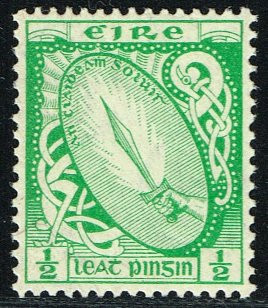
An Claidheamh Soluis
An Claidheamh Soluis
The second accepted design was by John J. O'Reilly. It featured the Sword of Light (An Claidheamh Soluis) in a mandorla set against zoomorphic ornaments. The top of the mandorla appears the inscription "An Claidheamh Soluis."
The Sword of Light appears in Gaelic tales from Ireland and Scotland. In Irish folktales, typically, the sword appears as a quest item. The tales often involve the hero's would-be bride or lost bride. There also are scholars that relate it to Excalibur. An Claidheamh Soluis also was the name of the journal of the Gaelic League (Conradh na Gaeilge). Among its editors was Pádraig Anraí Mac Piarais, one of the leaders of the 1916 Easter Rising.
Cros Chonga
The accepted design by Lily Williams featured a Celtic Cross (Cros Cheilteach) surrounded by shamrocks. The design is based on the twelfth-century Cross of Cong (Cros Chonga) made for the high king of Ireland, Tairrdelbach Ua Conchobair.
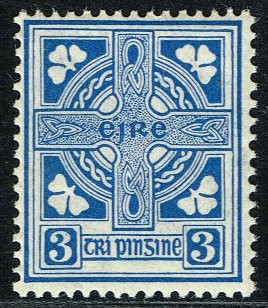
Cros Chonga
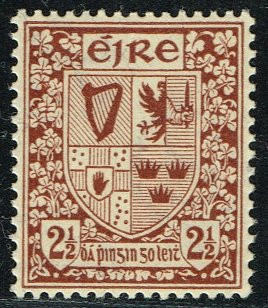
Cúigí
Cúigí
The final accepted design by Millicent Grace Girling featured a shield with the arms of the old Irish fifths (cúigí) against a background of shamrocks and zoomorphic ornaments. These fifths were the kingdoms of Gaelic Ireland. After Leinster (Laighin) and Mide (Mhídhe) had merged, four provinces remained. Clockwise starting with the northeast quarter appear the arms of
• Connacht (Cúige Chonnacht),
• Munster (Cúige Mumhan),
• Ulster (Cúige Uladh), and
• Leinster (Cúige Laighean).
Watermark
The stamps, originally, were printed on wove paper with a multiple "Se" watermark. The watermark has a Gaelic "s" set within a Gaelic "e." The letters stand for "Saorstát Éireann." From 1940, this watermark, gradually was replaced by the multiple "e" watermark. Click image below to see larger image.

Click for High Resolution Image
Coils
Rolls of stamps were made up from sheets of stamps. The sheets of stamps were cut or torn into horizontal or vertical strips. The strips were pasted together by the sheet margin, the so-called coil joins, to make longer strips. The paste-up strips were then coiled into rolls.
These rolls of stamps were produced for businesses that used stamp affixing machines. The device would hold a roll of stamps. It had a water reservoir, so the stamp could be moistened and affixed to the mail item. This was quicker than manually detaching a stamp from a sheet, licking the gummed side, and affixing the stamp.
In the early 1930s, the post office experimented with stamp vending machines. The stamps from the past-up rolls occasionally jammed the vending machines. The solution was found in the production of stamp rolls from continuous reels. The stamps from these rolls have imperforate edges.
Rolls of the 1d "Map of Ireland" stamps from continuous reels for use in vending machines with vertical delivery were introduced in April 1933. The stamps had horizontal perforation gauge 15. The vertical sides were imperforate but for a single perforation hole at the top of the stamp. From July 1934, the stamps from such rolls had fully imperforate sides. In 1935, the 2d "Map of Ireland" stamp also appeared perforated 15 x imperforate. This stamp is very rare.
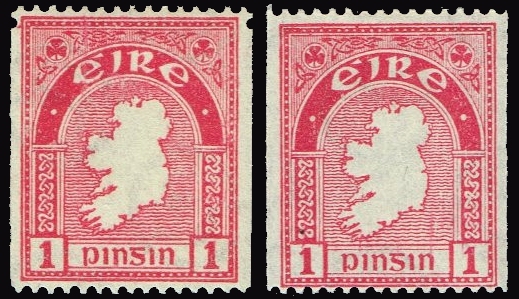
Horizontal Perforation Gauge 15

Vertical Perforation Gauge 14
In November 1934, rolls of 1/2d "Sword of Light" and 2d "Map of Ireland" stamps with sideways delivery were released. These were imperforate horizontally and had a vertical perforation gauge 14. These stamps, exclusively, were produced for businesses with stamp affixing machines.
1933 Coil Stamp Watermarks
The 1d "Map of Ireland" coil stamp for use in vending machines had imperforate vertical edges. The first such coil stamps issued in 1933 had a single feed perforation hole at the top. The stamps exist with both upright and inverted watermark. The feed perforations were a failure and coils with completely imperforate vertical edges were introduced in 1934. These, only, are known with upright watermark.
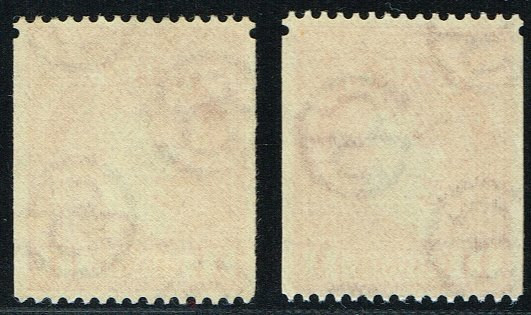
Watermark
1934 Stamp Affixing Machine Rolls Watermark
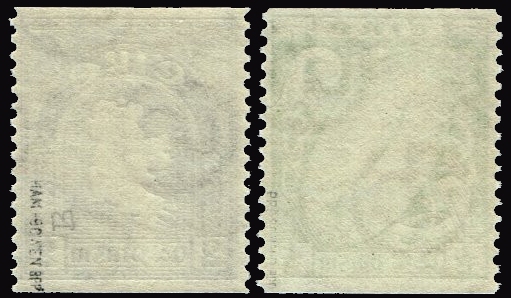
'Sideways' Watermark
The stamp rolls printed for use by businesses in stamp-affixing machines were printed sideways. They were imperforate top and bottom and had vertical perforation gauge 14. The watermark was sideways with the top of the "e" pointing to the left as seen from the front of the stamp. The Hibernian Handbook calls these "sideways right" as seen from the back of the stamp. It, however, does not mention the stamps have a sideways watermark.
Update: The 2020 Hibernian Handbook and Catalogue of the Postage Stamps of Ireland dates the issue of the 2d "Map of Ireland" stamp imperforate top and bottom to September 1934. The 2009 edition dated the issue to November 1934.
Inverted printing of booklet stamps
On 21 August 1931, the Irish Free State issued its first stamp book. The stamp book cost 2/- and contained four stamp panes. These were one each of 6 stamps of the 1/2d (Sword of Light), 1d, and 2d (Map of Ireland) stamps, and one pane of three 1d stamps over three advertising labels. The panes had two rows of three labels each with a binding margin to the left of the stamps. The advertising labels in the pane of three 1d stamps read "Get Telephone," "Buy Savings Certificates," and "Learn Irish," respectively. The panes were stitched together with cardboard covers.
The panes were printed in sheets of 44 panes of six labels. Each sheet consisted of four columns of 11 panes with a vertical gutter margin between columns 1 and 2, and columns 3 and 4. The panes of stamps in the first and third columns were printed inverted. Consequently, these stamps had the watermark inverted in relation to the design. The binding margin of each pane represents half of the vertical gutter margin between these columns. Once turned the right way up, all panes had this binding margin to the left of the stamps.
Another source for stamps with inverted watermark were those from printers' sheets fed upside down into the printing press. Generally, stamps from stamp books have the perforation tips on at least one side of the stamp cut straight.
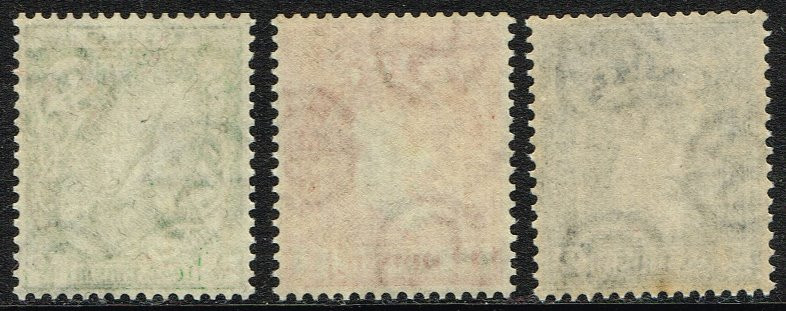
Inverted Watermarks
High Value Stamps
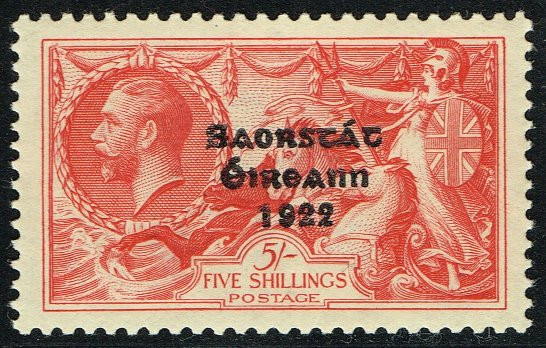
Overprint Seahorse
Ireland did not issue its own high value stamps until 8 September 1937. It continued using overprinted high-value British stamps, the so-called Seahorses, until that date. The re-engraved Seahorses that had been put into circulation in October 1934 were the last to be overprinted for use in the Irish Free State.
A single design by Richard Joseph King (Rísteard Ó Cíonga), a stained-glass artist, was adopted for the first Irish high-value stamps. The stamp depicted Saint Patrick, Ireland's patron saint, lighting the paschal fire on the Hill of Slane (Dumha Sláine). The style of the design is Art Deco.
In the Irish pagan tradition, the High King of Ireland would light a ceremonial fire at Tara. The ceremony coincided with the eve of Easter. From the fire at Tara all fires in Ireland would be lit. The law forbad the lighting of a fire when this ceremonial fire was burning. On one such eve, Saint Patrick lighted a fire on the nearby Hill of Slane.
When King Laeghaire saw the fire, he summoned his druids. They prophesied that if the fire would not be extinguished that night, it will over-top all their fires, and that he who had lit it would overturn the Kingdom. The King, accompanied by some of his courtiers rode to the Hill of Slane. One of the courtiers was converted by the saint. Saint Patrick himself was directed to appear the next day at Tara and give account of his proceedings before the assembled court. There, he explained the Christian doctrine to the court and silenced the druids. Although King Laeghaire was not converted, he permitted Patrick and his missionaries to preach their doctrines throughout his dominions.
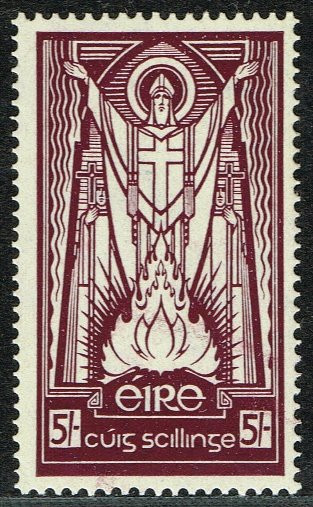
Saint Patrick and the Paschal Fire
1937 Saint Patrick High Values Watermark
The high value stamps had the multiple "se" watermark upright. All three are known with inverted watermark.
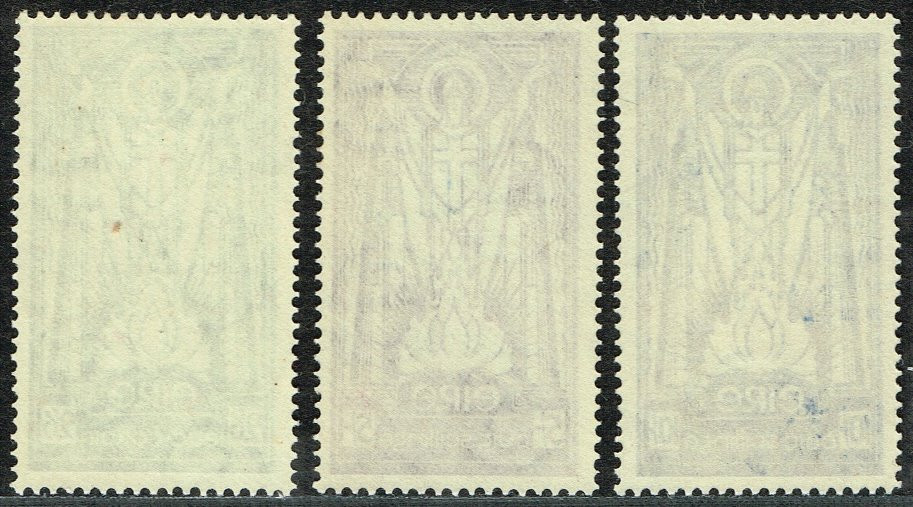
From Saorstát Éireann to Éire
On 21 January 1919, a gathering of Irish members elected to the British parliament established the Dáil Éireann. This adopted the Forógra na Saoirse (Proclamation of Freedom) that ratified the Forógra na Poblachta (Proclamation of the Republic) of 1916. The Anglo-Irish Treaty established the Irish Free State as a dominion of the British Commonwealth of Nations. By signing the treaty, effectively, the Irish government abolished the revolutionary Irish Republic declared in 1919. The official head of state remained the British King.
Amendments to the Irish constitution drafted in 1922 removed the Oath of Allegiance to the British King and appeals to British institutions. Nonetheless, the Irish government formed by the Fianna Fáil party led by Éamon de Valera drafted a new constitution. The proposed Irish constitution (Bunreacht na hÉireann) was put to a plebiscite on 1 July 1937. 56 percent of the voters, making up 36.8 percent of the electorate were in favour of the new constitution.
The new constitution established the position of an elected President of Éire (Uachtarán na hÉireann), and calling named the state Éire. It came into force on 29 December 1937. This was commemorated by the two stamps issued on the same day.

From Saorstát Éireann to Éire
The new name of the RepublicÉire, also, would be reflected in the watermark of Irish stamps. From 1940, stamps were printed on paper with the multiple Gaelic e of Éire watermark that replaced the multiple Gaelic "se" of the Saorstát Éireann. "Symbols of Ireland" definitive stamps printed on paper with the new watermark, gradually, replaced those on the old watermark.
Both above stamps commemorating the 1937 constitution and the high value stamps, issued after the plebiscite of 1 July 1937, were printed on paper with the multiple "se" watermark of the Irish Free State.

Watermark
1940 – 1949 With Watermark Album Page
During 1940, most stamps from the series appeared printed on paper with the multiple "e" watermark. The 2 1/2d stamp did not appear on this paper until March 1941. The 6d stamp was the last to appear on paper with this watermark, a year later. In 1967, a re-printed 6d stamp on chalk-surfaced paper was released. It is interesting to note that the Hibernian handbook lists the stamp but does not provide information on when it was issued.
On 12 September 1949, the 8d and 11d values complemented the existing range. By this time, the ½ d and 1/- values had been replaced by the two stamps commemorating the 300th. anniversary of the death of Mícheál Ó Cléirigh.
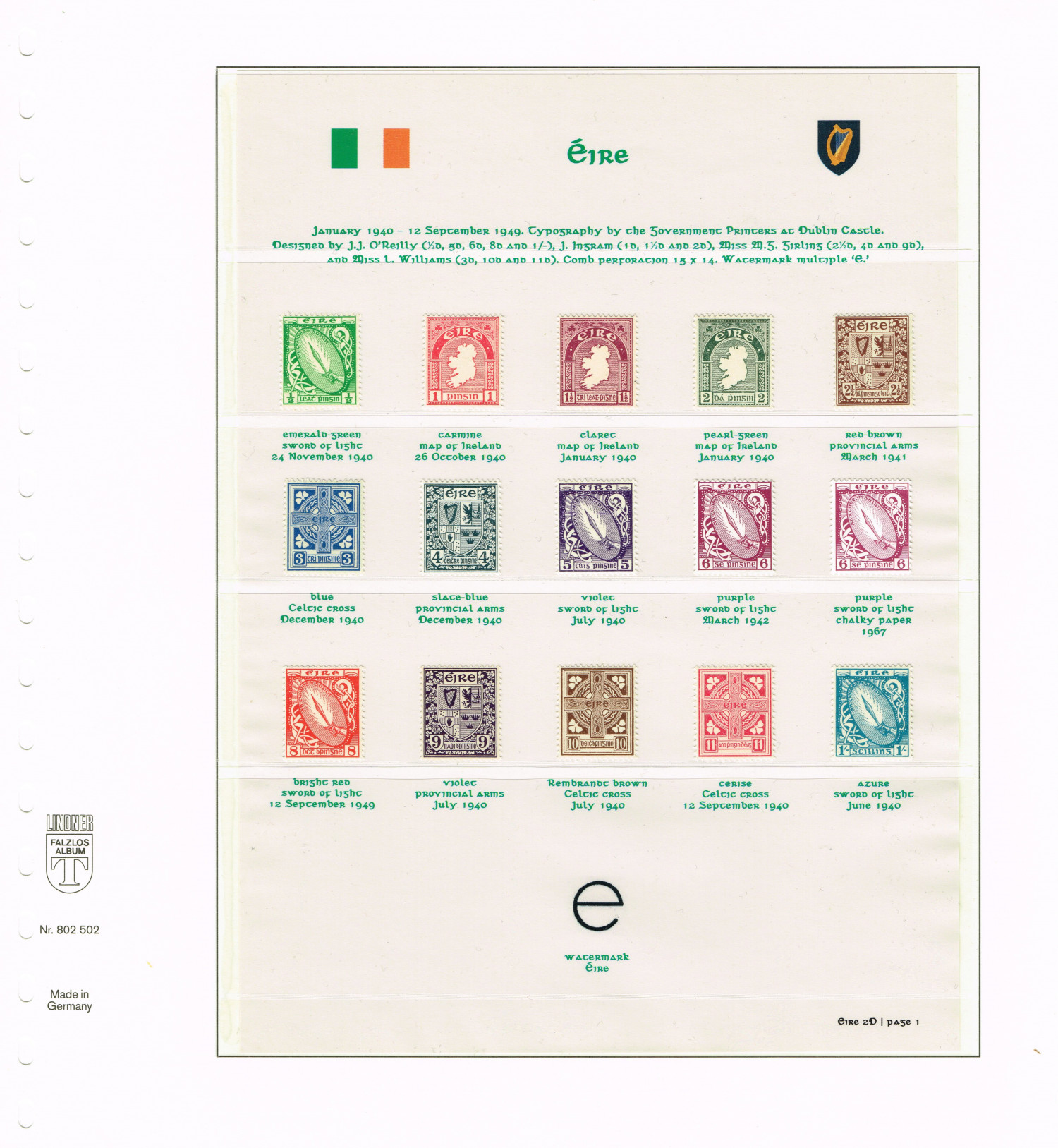
Click for High Resolution Image
6d Ordinary and Chalk-surfaced Papers
The 6d stamps with multiple "e" watermark was re-printed on chalk-surfaced paper. This paper is markedly whiter than the creamy ordinary paper, This, especially, is visible in the centre of the mandorla. The impression of the stamp on chalk-surfaced paper is much finer. The shading is cleaner than that of the stamp on ordinary paper. This is best visible in the shading of the mandorla and the lower right corner. At the lower end of the zoomorphic ornament to the right of the mandorla, the topmost lines of shading in this area are better defined on the chalk-surfaced paper.
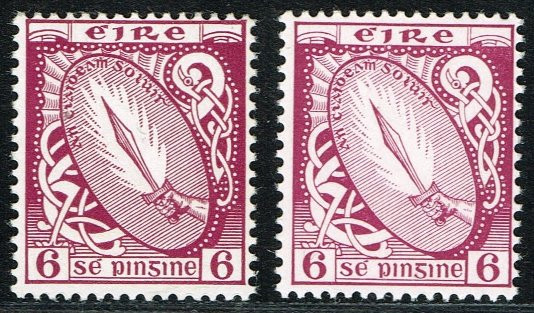
Ordinary Paper on Left - Chalk-surfaced Paper on Right
Commemorative Definitives
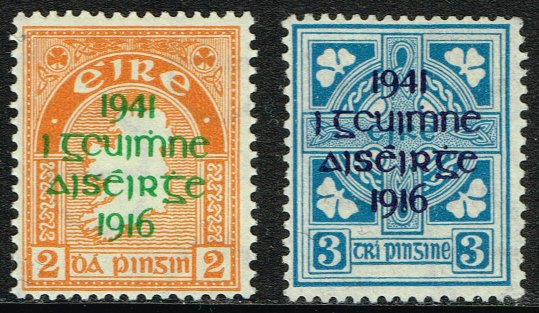
A month after the British government declared war on Germany, the Bráithreachas Phoblacht na hÉireann (Irish Republican Brotherhood) decided to stage an uprising before the end of the war. They sought help from Germany for this rising. On Easter Monday, 24 April 1916, the rising began. On Saturday 29 April 1916, the rebels surrendered unconditionally to avoid further loss of civilian life.
The leaders of the insurrection were tried before courts martial and executed. This and the British reaction to the insurrection increased popular support for Irish independence.
The 25th. anniversary of the 1916 Easter Rising was commemorated with a stamp issue. On 12 April 1941, the eve of Easter, a provisional set of two stamps was issued. The definitive stamp was issued on 27 October 1941. This stamp shows an insurgent in front of the General Post Office the insurgents used as their headquarters.
The provisional issue comprised a 2d "Map of Ireland" and a 3d "Cros Chonga" stamp. The designs were those of the contemporary definitives series. Both stamps were overprinted "1941 I gcuimne Aiséirge 1916" (In memory of the Rising 1916) in three lines. The 2d stamp was printed in orange, a colour not used for the definitives series. It had a green overprint. The 3d stamp was printed in blue, the same colour as the stamp from the definitives series. It had a violet overprint.
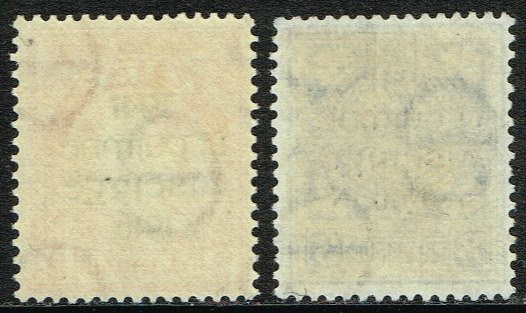
Other than the colour of the 2d stamp and the overprint, both stamps are like their definitive counterparts. These were the first commemorative stamps printed on the multiple "e" watermarked paper.
Definitive commemoratives
On 30 June 1944, two stamps were issued to commemorate the tercentenary of the death of brother Mícheál Ó Cléirigh, co-author of the Annals of the Four Masters. The stamps, originally, were issued as commemoratives. After issuance, they became part of the definitives series, replacing the 1/2d and 1 s "Sword of Light" stamps. They remained in use until superseded by the Gerl definitives, in 1969.
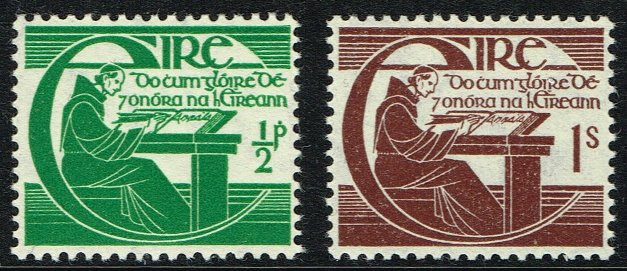
Mícheál Ó Cléirigh
The stamps depict Ó Cléirigh at his desk enclosed by the "e" of Eire in the style of illuminated miniatures. The manuscript which he is writing is titled "Annala." The caption in Irish Gaelic "Do chum glóire Dé agus onóra na hÉireann" means To the Glory of God and the Honor of Ireland.
Mícheál Ó Cléirigh was born and educated in Ireland. He studied Irish history and literature before he entered the Franciscan Irish College of Saint Anthony in Louvain (currently in Belgium). Together with fellow scholars, brother Mícheál Ó Cléirigh returned to Ireland to collect and transcribe Irish manuscripts. In 1632, they began to assemble a set of Irish annals. The Annals are a chronicle of Irish history from A.M. 2242 (Great Flood) to A.D. 1616 and contain records under successive years of the deaths of kings and other prominent persons, both ecclesiastical and lay, along with accounts of battles, plagues, etc. They end with the death of Hugh O'Neill, earl of Tyrone, in 1616.
The work took four years to compile and was known as Annála Ríoghachta Éireann (Annals of the Kingdom of Ireland), or Annals of the Four Masters. The four masters refer to four of the scholars, including brother Mícheál Ó Cléirigh. Among his further works is a glossary that was printed during his lifetime, in 1643. Mícheál Ó Cléirigh returned to Louvain, where he died around 1643.
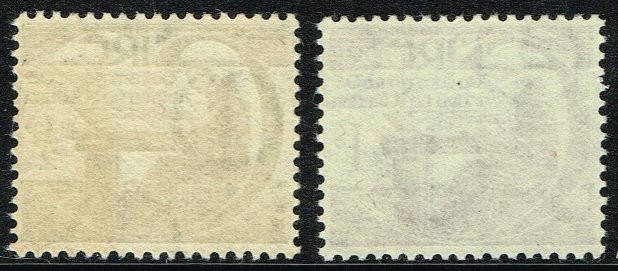
The stamps have the watermark sideways: seen from the front, the "e" reads from top to bottom with the top pointing to the right. In 1946, booklets were issued with panes of six of the 1/2d stamps from this issue. These had the watermark both sideways and sideways inverted (the "e" reads from bottom to top with the top pointing to the left) in the normal course of printing).

I am not 100 percent sure the left stamp shown above has the sideways watermark
Both stamps exist with sideways inverted watermark from counter sheets. The 1 s stamp with sideways inverted watermark, only, originates from counter sheets.


Coil stamps
Rolls of the 1d "Map of Ireland" stamps from continuous reels for use in vending machines with vertical delivery with multiple "e" watermark became available from 29 April 1940. This was almost six months before the 1d stamp from sheets became available.
Like the coil stamps with the multiple "se" watermark issued in 1934, these had imperforate vertical sides. The horizontal perforation gauge, however, was 14. The reason for using this new gauge is unknown. One possible explanation is that the machine used for production of the 1/2d and 2d rolls with multiple "se" watermark with horizontal feed was used with the spacing between rows changed.

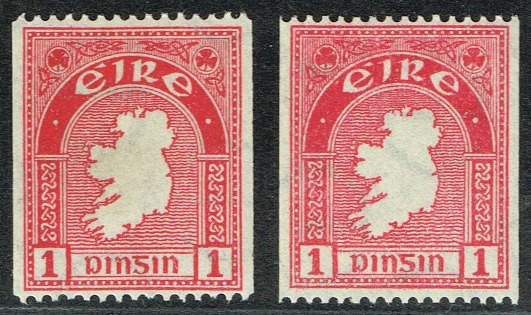
In 1946, at least two further printings of the coil were made. These had imperforate vertical edges and horizontal perforation gauge 15. The first printing had the watermark upright, the second had the watermark inverted. Stamps from this second printing have a slightly brighter shade.
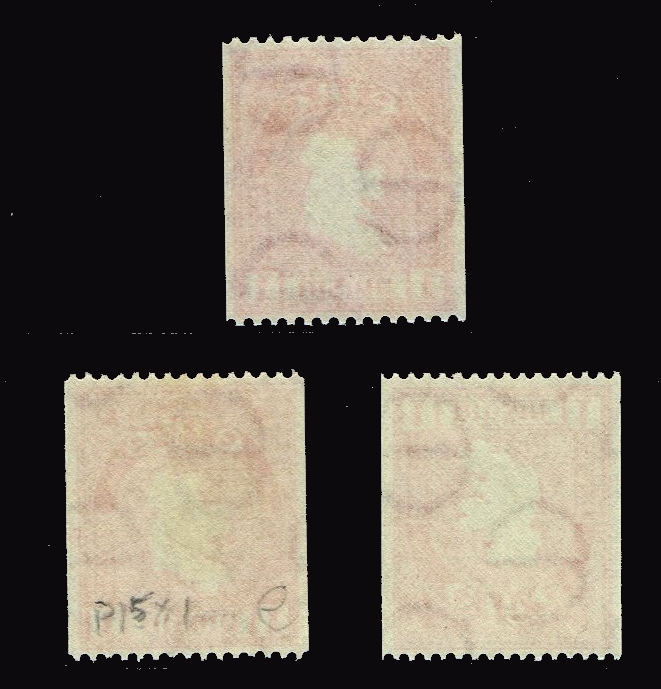
Watermarks
1940 – 1960 Booklet stamps
Up to 1964, two small numbers separated by a dash appear on the cover of Irish stamp books. These represented the last two digits of the year of issue and a serial number. In 1938, the order was changed. The 2/- stamp book 22-40, issued in 1940, exists in two versions. One version has all panes with the multiple "se" watermark. A large part of this edition, however, has the pane of three 1d "Map of Ireland" stamps and three advertising labels with the multiple "e" watermark. From edition 23-40 onwards, all panes had the multiple "e" watermark. As before, the panes were printed in columns with alternating directions of printing. The booklet stamps, therefore, exist both with upright and inverted watermark.
From edition 29-46, panes of six 1/2d "Mícheál Ó Cléirigh" stamps substituted for panes of six 1/2d "Sword of Light" stamps. In 1948, the price of the stamp book was increased from 2/- to 2/6. The content changed to a pane of six 1/2d, two panes of six 1d, and a pane of six 2 1/2d "Arms of the Provinces" stamps. The first edition of this stamp book was 31-48.
The price of a stamp book increased from 2/6 to 4/- with edition 37-54 issued on 24 November 1954. Stamp book 37-54 contained a pane of six 1/2d, a pane of six 1 1/2d "Map of Ireland," and two panes of six 3d "Celtic Cross" stamps. Subsequent booklets had different contents. On 23 October 1962, the price of a stamp book changed to 3/-. Edition 43-62 contained one pane each of six 2d and six 4d "Arms of the Provinces" stamps.
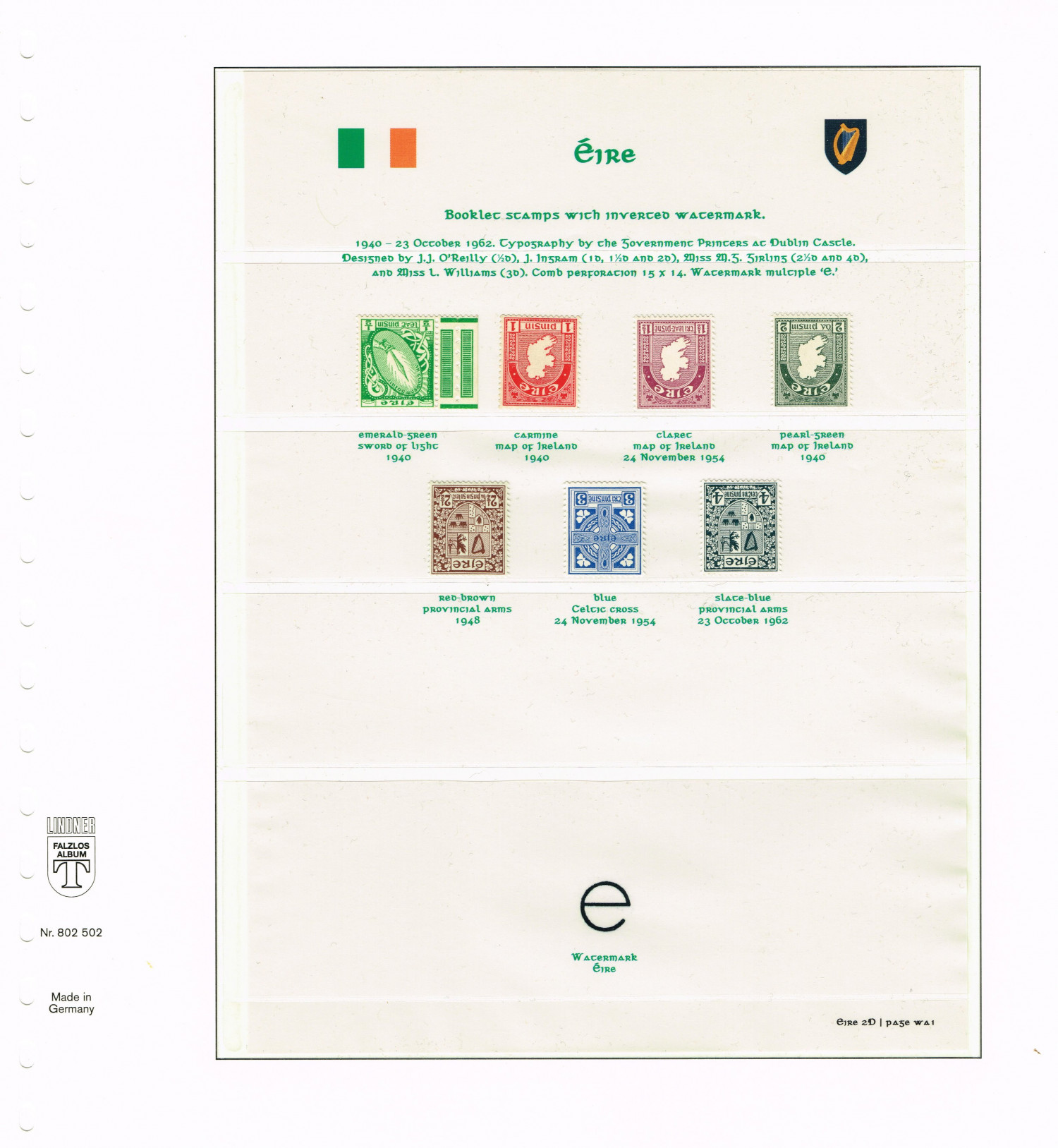
Saint Patrick and the paschal fire Éire watermark
From 1942, the three high-value stamps depicting Saint Patrick lighting the paschal fire on Hill of Slane appeared on paper with the Éire watermark. The known first days of use for the half crown and crown issues are 10 February 1943 and 15 December 1942, respectively. The 10/- stamp was not reported on paper with this watermark until July 1945. These high-value stamps were superseded by those in the new designs by Heinrich Gerl from 14 October 1968. A late printing of the high values depicting Saint Patrick took place on chalk-surfaced paper. These stamps were issued in 1968.
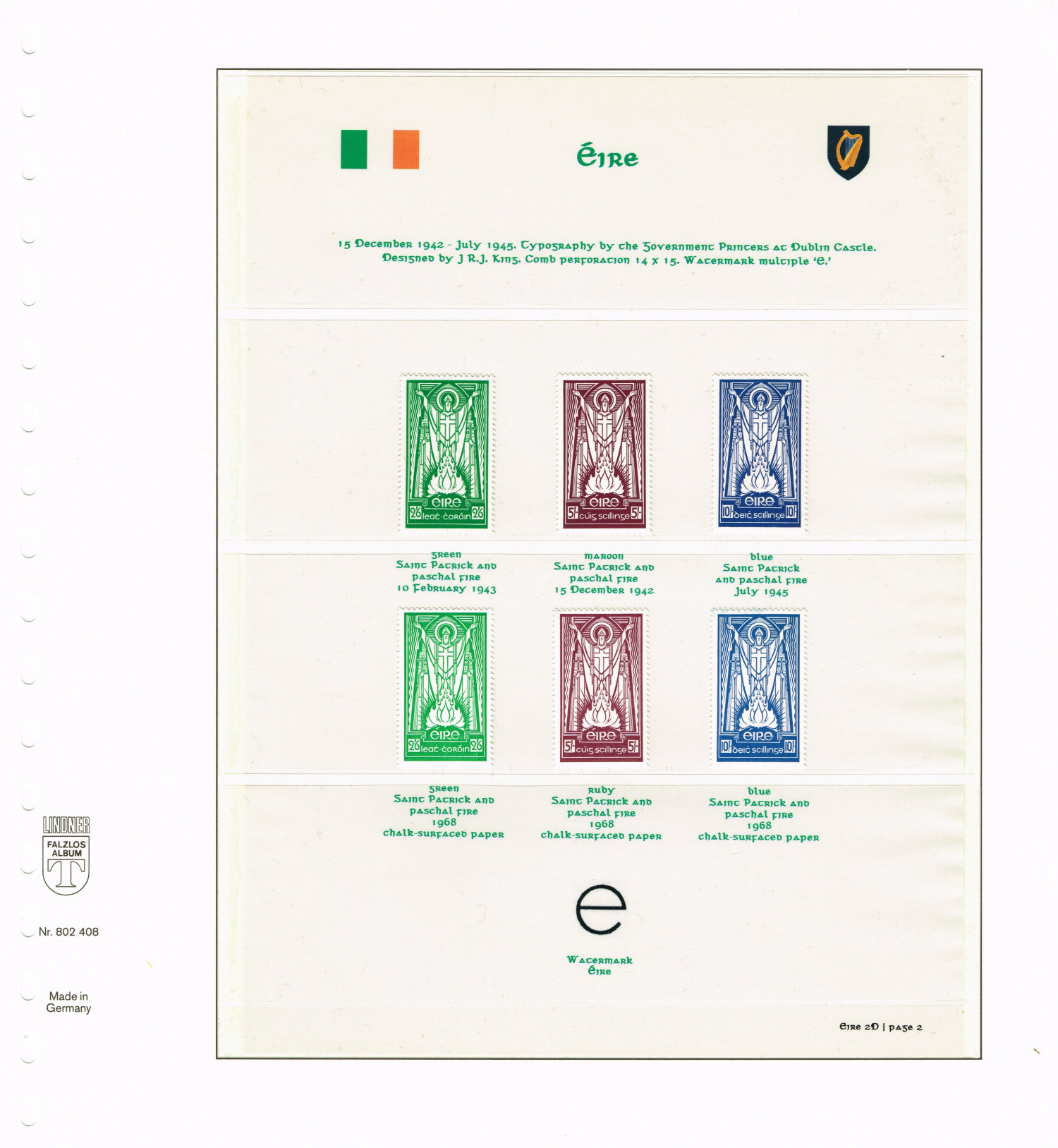
The chalk-surfaced paper is whiter than the ordinary paper that has a creamy appearance. Although shade differences exist, the stamps printed on the creamier ordinary paper tend to have a deeper colour. The listing of the 2/6 stamp by Stanley Gibbons suggests this is not always the case. The Hibernian Handbook only uses distinct colours for the 5/- issues. It describes the issue on ordinary paper as maroon and that on chalk-surfaced paper as ruby. Each of below images shows the stamp on ordinary paper at the left and that on chalk-surfaced paper on the right.
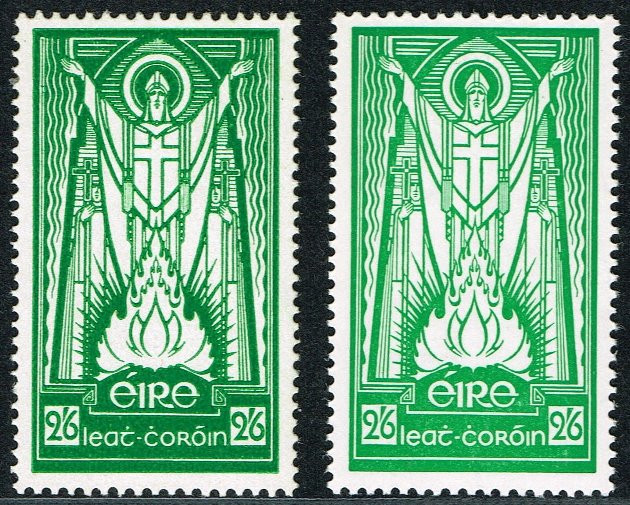
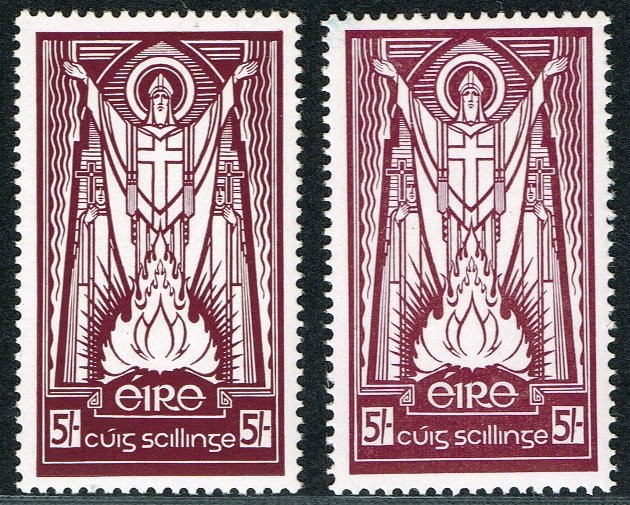
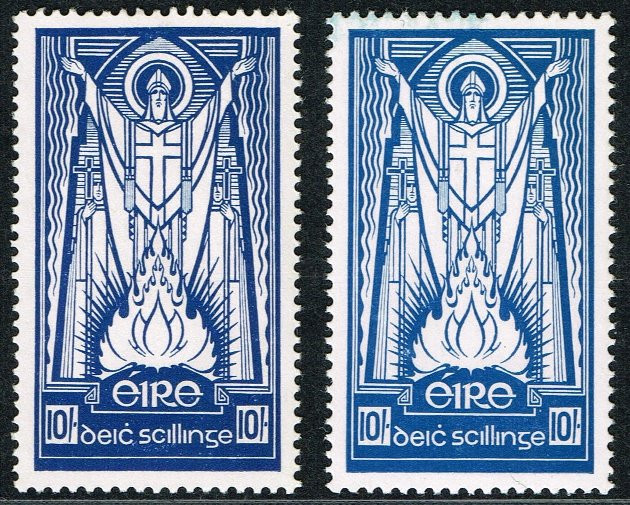
Watermarks
The watermarks tend to be easily visible, especially on those printed on the creamier ordinary paper. In fact, they are less visible in below images than they are when seen at an angle to the light, even without holding them against a dark background. This may be due to the thickness, or rather the lack thereof, of the paper. The ink of the 5s stamp on "ordinary" paper shown below, especially, permeates the paper. Except for the 10s value on chalk-surfaced paper, all stamps have been reported with inverted watermark.
Ordinary paper
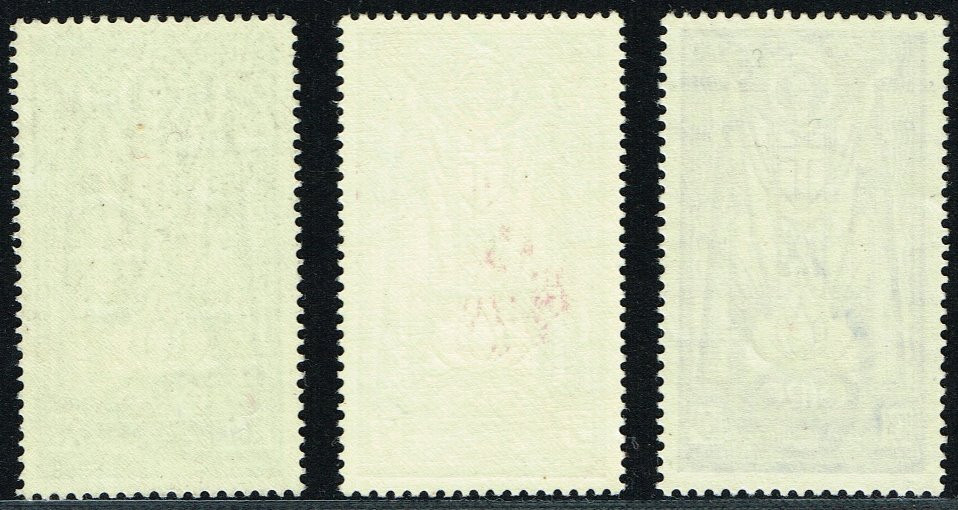
Chalk-surfaced paper
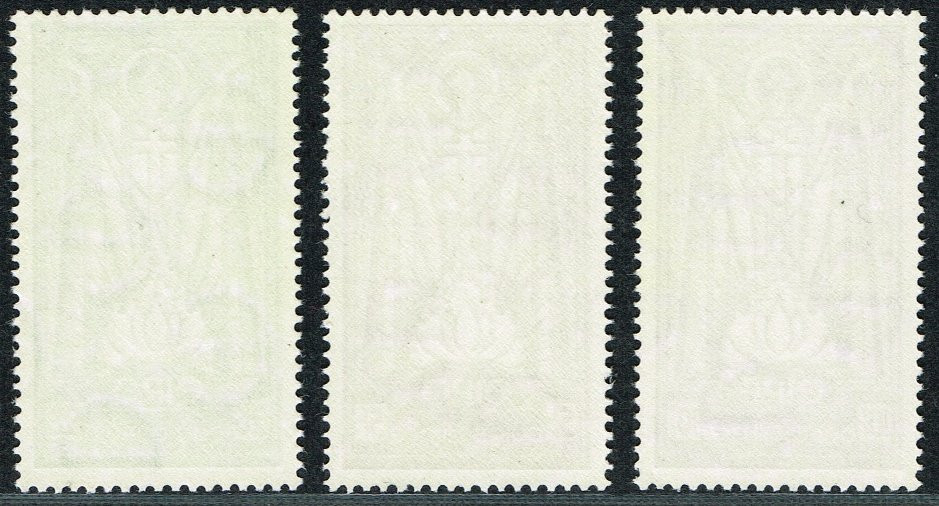
The images also show the difference in the whiteness of the gums. The earlier printings of these stamps were on papers with a creamy, off-white gum. Later printings were on paper with a white gum.
Stamps printed in photogravure
On 1 December 1966, a new 5/- stamp book containing two panes of six 5d "Sword of Light" stamps was put on sale. A further 2/6 stamp book with a single pane of six of the same stamps became available from slot machines installed inside the Dublin General Post Office and three further Dublin branch offices from 9 December 1966. The stamps from these panes were printed in photogravure on chalk-surfaced paper. They had a smaller format design than the typographed stamps. Below image shows the letterpress-printed (left) and photogravure-printed (right) stamps.
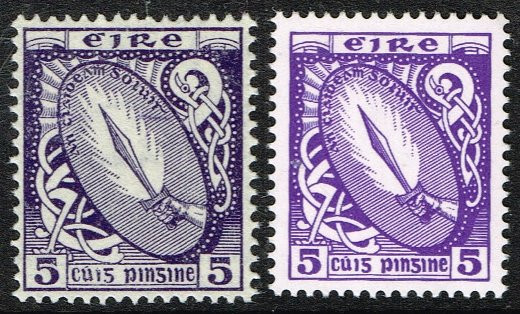
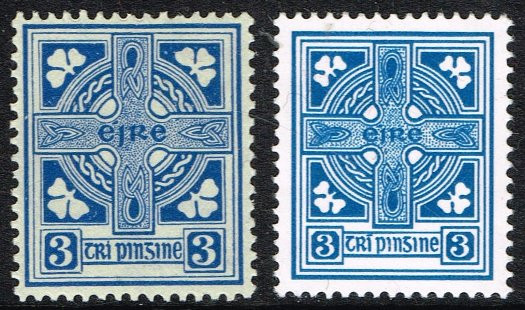
In 1967, the Department of Posts and Telegraphs announced the existing permanent series printed by letterpress would gradually be replaced, commencing in August 1967, by stamps of the same design printed in photogravure. The announcement informed a 3d stamp printed in photogravure would be put on sale at the General Post Office, Dublin, on 1 August 1967. It, subsequently, would be introduced at other post offices as supplies of the letterpress-printed 3d stamp became exhausted. Around the same time, the Department of Posts and Telegraphs announced the permanent series was due for replacement by stamps in new designs. Below image shows the letterpress-printed (left) and photogravure-printed (right) 3d "Celtic Cross" stamps.
Ireland was a late adopter of the photogravure process for printing stamps. Its first stamps printed in photogravure were the two stamps issued on 2 December 1963 commemorating the centenary of the International Red Cross. Until 1965, photogravure stamps were printed by the British printers Harrison and Sons, Ltd. The stamps commemorating the centenary of the birth of William Butler Yeats issued on 14 June 1965 were the first printed by the Irish Government Printers.
The 5d "Sword of Light" stamp was the first to be printed in photogravure. The printing was done by the Irish Government Printers. Between 1 December 1966 and 1 April 1968, the 5d stamp printed in photogravure, only, was available from stamp books. On 1 April 1968 it, also, was put on sale from counter sheets. No further stamp of the series printed in photogravure was issued. The "Gerl" series replaced the "Irish symbols" series from 14 October 1968 onwards.
Whereas the Hibernian Handbook speaks of typography, the Department of Posts and Telegraphs speaks of letterpress. These terms refer to the same printing process. Collectors of British stamps also use the terminology "surface printed."
